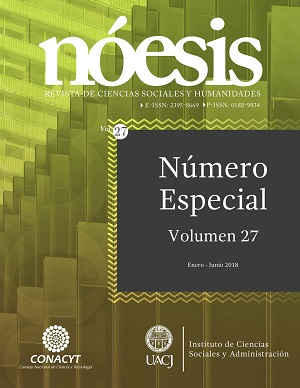The wage inequality in the manufacturing industry of the border of Mexico and the United States, 1994-2014
Main Article Content
Abstract
In this article we make a comparative analysis of the wage inequality that exists in the manufacturing industry of the neighboring states in the border area between Mexico and the United States. For which we conducted a study of the inequality of wages, in the states of the Mexican side: Baja California, Sonora, Chihuahua, Coahuila, Nuevo Leon and Tamaulipas; and in the US states of: California, Arizona, New Mexico and Texas. To carry out this analysis we use the methodology developed by Shorrocks (1982, 2012). According to our results, we find that, above all inequality within the states is what explains this reduction in inequality.
Downloads
Article Details

This work is licensed under a Creative Commons Attribution-NonCommercial-ShareAlike 4.0 International License.
References
Acemoglu, Daron y David Autor. 2011. Skills, tasks and technologies: Implications for employment and earnings. En Handbook of Labor Economics, editado por Orley Ashenfelter y David Card. Amsterdam: North Holland, 1043-1171.
Anderson, Joan y James Gerber. 2008. Fifty years of change on the U.S. -Mexico border. Texas: University of Texas Press.
Bhattacharya, Nath y B. Mahalanobis. 1967. Regional disparities in household consumption in India. Journal of the American Statistical Association, 62 (317): 143-161.
Calderón, Cuauhtémoc, Luis Huesca y Gloria Ochoa. 2017. Análisis comparativo de la desigualdad salarial entre México y Estados Unidos. Investigación Económica, 76 (300): 3-31.
Consejo Nacional de Evaluación de la Política de Desarrollo Social. 2017. http://www.coneval.org.mx/Paginas/principal.aspx (09 de octubre, 2017).
Consejo Nacional de Población. 2017. https://www.gob.mx/conapo (11 de octubre, 2017) .
Current Population Survey (CPS). 2017. U.S. Census bureau, current population survey, annual social and economic supplement. https://www.census.gov/programs-surveys/cps.html (12 de septiembre, 2017).
Encuesta Nacional de Empleo Urbano. 2017. (12 de septiembre, 2017).
Encuesta Nacional de Ocupación y Empleo. 2017. http://www3.inegi.org.mx/sistemas/temas/default.aspx?s=est&c=25433&t=1 (12 de septiembre, 2017).
Huesca, Luis y Gloria Ochoa. 2016. Desigualdad salarial y cambio tecnológico en la frontera norte de México. Problemas del Desarrollo, 47 (187): 165-188.
Kolenikov, Stanislav y Anthony Shorrocks. 2005. A decomposition analysis of regional poverty in Russia. Review of Development Economics, 9 (1): 25-46.
Morduch, Jonathan y Terry Sicular. 2002. Rethinking inequality decomposition, with evidence from rural China. Economic Journal, 112 (476): 93-106.
Ochoa, Gloria, Luis Huesca y Cuauhtémoc Calderón. 2015. Descomposición de la desigualdad salarial en los estados de la frontera norte de México. Economía Informa, (393): 3-20.
Population Division, Banco Mundial. 2017. https://datos.bancomundial.org/indicador/SP.POP.GROW?locations=LB&display=graph (12 de septiembre, 2017).
Prebisch, Raúl. 1971. Transformación y desarrollo: La gran tarea de América Latina. Chile: Cepal, Naciones Unidas.
Rodríguez, Reyna, Luis Huesca y Mario Camberos. 2011. Mercado laboral, inequidad salarial y cambio tecnológico. Frontera Norte, 23 (45): 7-33.
Shapley, Lloyd. 1953. A value for N-person games. En Contributions to the theory of game, editado por Harold Khun y Albert Tucker. Princeton: Princeton University Press, 307-317.
Shorrocks, Anthony. 1982. Inequality decomposition by factor components. Econometrica: Journal of the Econometric Society, 50(1): 193-211.
Shorrocks, Anthony. 2013. Decomposition procedures for distributional analysis: a unified framework based on the shapley value. Journal of Economic Inequality, 11(1): 99-126.
Sistema de Cuentas Nacionales de México. 2017. http://www.inegi.org.mx/default.aspx (14 de octubre, 2017).
Tamayo, Jesús y José Luis Fernández. 1983. Zonas fronterizas (México-Estados Unidos). Ciudad de México: CIDE
Torres, Aldo y Gustavo Félix. 2017. Rendimiento al uso de PC en México: un análisis comparativo por sector de actividad. (10 de marzo. 2017).
US Departament of Commerce, Bureau of Economic Analysis. 2017. https://www.bea.gov/ (12 de septiembre, 2017).
US Department of Commerce, Bureau of Economic Analysis, U.S. Census Bureau. 2017. https://blog.bea.gov/category/u-s-census-bureau/ (12 de septiembre, 2017).

